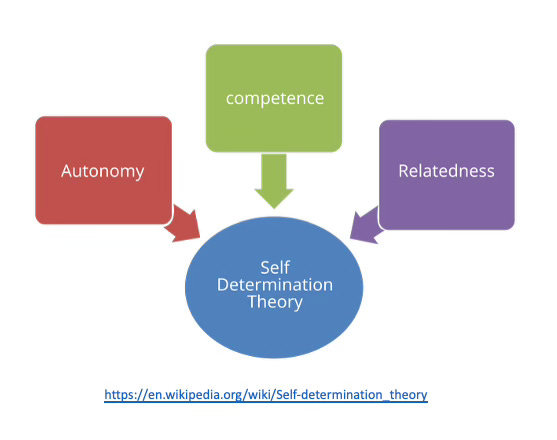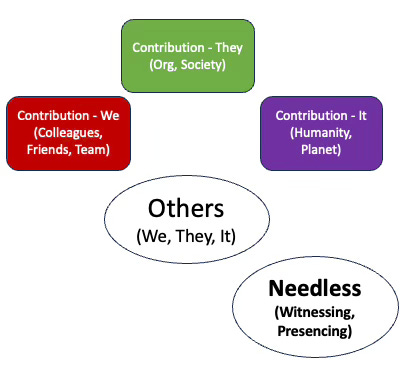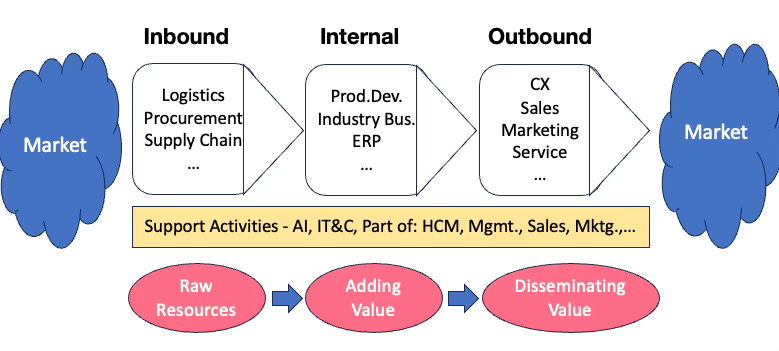The Shift from Extraction to Contribution
When people rediscover their wholeness, a new question naturally arises: How does this wholeness contribute to life beyond itself?
Value Co-Creation is the second pillar of aliveness — the movement from the individual to the relational. It marks the point where an organisation stops seeing value as something it produces for others and begins seeing it as something it creates with others.
In a mechanistic system, value is extracted. In a living system, value is exchanged and amplified through relationship. This is the essence of contribution at scale.
From Beliefs toward Actions
Every organisation acts out its beliefs about value. If the hidden belief is “resources are scarce”, behaviour will be protective, competitive, zero-sum. If the belief is “life is abundant and cooperative”, behaviour will be generous, curious, and innovative.
The primal beliefs explored earlier — Safe, Enticing, Alive — manifest here as three types of organisational energy:
When these energies align, the organisation’s relationships — internal and external — become value-creating ecosystems.
What Value Co-Creation Means
To co-create value is to participate in the ongoing evolution of all parties involved — employees, customers, partners, communities, even the planet.
Value is no longer a one-way transaction. It is a reciprocal learning loop: we offer, receive feedback, evolve, and in that evolution create new value.
An Alive Organisation understands that:
Value emerges through relationship, not isolation.
Every stakeholder is a co-author, not a recipient.
Profit is a by-product of purpose expressed collectively.
Thus, co-creation becomes both an economic and developmental practice — an act of mutual becoming.
The Psychological Foundations
Value Co-Creation rests on the Self-Determination Theory (SDT) developed by Deci & Ryan, which identifies three universal psychological needs:
Autonomy — to act from inner volition rather than control.
Competence — to feel effective and capable of impact.
Relatedness — to feel connected and significant to others.
When organisations honour these needs across their relationships, engagement becomes intrinsic. People contribute because the act itself is fulfilling.
Alive Organisations extend this triad beyond individuals to the collective level — creating autonomous teams, competent ecosystems, and related partnerships.
The Evolution of Contribution
Human contribution evolves through concentric circles of care:
Contribution to We — within teams and close colleagues.
Contribution to They — to the larger organisation and its customers.
Contribution to It — to humanity, society, and the planet.
Needless Contribution — pure witnessing; doing for the joy of serving life itself.
As development progresses, individuals and systems naturally expand their circle of concern. Value Co-Creation thus becomes both a business practice and a map of human evolution.
From Self-Protecting Mindsets to Self-Fulfilling Mindsets
In a self-protecting organisation, energy flows inward: maintaining control, securing credit, avoiding loss.
In a self-fulfilling organisation, energy flows outward: exploring, sharing, co-creating.
The shift between the two happens when fear is replaced by trust and competition by curiosity. This is not naïve idealism — it is adaptive intelligence. Systems that hoard collapse; systems that share evolve.
The Value Chain Reimagined
Traditional business describes a value chain: inbound → internal → outbound.
Alive Organisations reinterpret this chain as a value circle, where every phase both gives and learns.
Inbound (Suppliers & Partners) — relationships built on co-innovation and mutual growth, not price pressure.
Internal (Employees & Teams) — learning organisations where doing and developing are the same process.
Outbound (Customers & Communities) — collaborations that enrich both lives and ecosystems.
Across all, foundational practices such as developmental coaching, transparent decision-making, and reflection ensure that collaboration itself is the main generator of value.
The Benefits of Value Co-Creation
When this relational paradigm takes root, profound transformations follow:
Greater Psychological Resilience — challenges become shared growth opportunities.
Enhanced Innovation & Creativity — diversity of voices sparks new possibilities.
Intrinsic Motivation — curiosity and meaning replace extrinsic pressure.
Sustainable Performance — innovation becomes ongoing, not episodic.
Improved Well-being — connection and autonomy reduce burnout.
Cultural Differentiation — trust and openness attract creative talent.
Decentralised Agility — decisions made closest to knowledge accelerate response.
These are not perks; they are the physiology of a living system in equilibrium with its environment.
Practices that Anchor Co-Creation
Alive Organisations weave co-creation into their daily fabric through concrete yet evolving practices:
Shared Purpose Design — stakeholders co-define the “why” of projects before the “what.”
Dialogue Spaces — regular cross-boundary conversations where insight and empathy grow.
Transparent Information Flow — access replaces gatekeeping; knowledge circulates freely.
Feedback as Learning — feedback loops connecting every actor in the value circle.
Partnership Metrics — measuring trust, collaboration quality, and mutual development alongside profit.
These practices transform collaboration from a coordination exercise into a living conversation.
The Enticing Organisation
The opposite of a dull organisation is not merely an entertaining one; it is an enticing one — a system that stimulates curiosity and wonder. In an enticing organisation, people experience work as discovery. The atmosphere invites exploration, not exhaustion.
Leaders in such systems see themselves as gardeners of fascination: they cultivate conditions for surprise, play, and shared creation. Enticement is not distraction; it is the emotional signature of a learning system in motion.
A Living Definition
Value Co-Creation is the capacity of an organisation to transform every relationship — internal and external — into a field of mutual contribution where meaning, learning, and value emerge together.
It is the practice of turning transaction into transformation, competition into collaboration, and work into co-evolution.
Bridge to the Next Pillar
Once the relational field is alive, another questions appears:
- What guides this collective energy?
- What gives direction to all this creativity and connection?
That question leads to the next pillar — Alive Purpose — where contribution aligns with a sensing, adaptive purpose that evolves with life itself.
Enjoy reading and applying these content. If you’d like to receive additional information regarding Alive Organisations topic please subscribe below.







